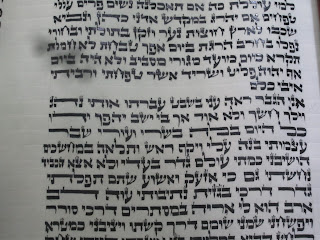I hope this doesn't break the no commercial content rule; if it does I will gladly delete it. The picture below is an amud from my second-ever megilla, this time Eicha. I have better sections and worse ones but this is pretty representative. I was hoping to sell the finished product for about $400 US. Is this reasonable, and if not how much would you say it's worth?
 |
| Note that the smudge was on the lens, not the klaf |
 |
| The whole amud at higher resolution. Click the image for a very close-up view. |
As you can see, I also need any writing tips I can get. Different parts of this amud were written at different times. What do you recommend to keep the ink at the same consistency between sessions and the kulmus at the same width after sharpening?
EDIT: Thanks for all the advice, I really appreciate professionals like you taking your time to give me beginner tips. Here are two new pictures of the same amud.



its hard to tell in the picture. can you post a closer up one?
ReplyDeleteIn terms of keeping kulmus the same thickness every time you sharpen it, try using a digital caliper to measure the width
Same comment here. The picture is not close enough to tell much about the quality of the Ksav.
ReplyDeleteSame comment here. The picture is not close enough to tell much about the quality of the Ksav.
ReplyDeleteJust a few thoughts on keeping your writing crisp and even.
ReplyDelete1. Sharpen your kulmus about every 10 lines or so. You don't have to reshape the whole quill to do this, just slice a thin sliver from the underside and you're set to go. Knowing this trick will really help keep your writing the same size, because you don't have to fuss with getting the whole pen exactly right.
2. Always test your kulmus before you write with it. Ask your klafmacher for scraps of ruled klaf the same size as the text you're working on. Then, before you write make sure that the nib of your kulmus is exactly 1/6, 1/7 or 1/8 the width of your line depending on what proportion you use when you write.
3. Write a few lines of text before you begin to keep as an example. Pin it to your writing desk and refer to it frequently as you write.
4. Use a folding tikkun where the ksav is the same size as the writing you are trying to produce.
5. If you're just starting out you might want to try using the klaf ruled up with the double lines.
6. Try to get used to writing for longer periods say a whole amud in a day. Not only will this train your hand to writing more evenly, but if you're finishing your projects quickly it's unlikely your ksav will change too noticeably.
All in all I wouldn't worry about it too much, my guess is that if you go on to writing a sefer Torah your ksav will settle into almost mechanical regularity somewhere around Vayikra.
I agree with most of your points except the one about sharpening your Kulmus every 10 lines or so. One of the best things that I ever did to improve my Ksav was that years ago I started forcing myself to get my kulmus how I want it before I start an amud and then not touch it until I finished the entire Amud. I held myself to this rule even if it seemed to me that adjusting the kulmus would improve the writing.
DeleteWhat this did over time was teach me how to adjust my hand to the conditions of the klaf instead of the kulmus. This made it that my writing is always exactly the same width across and amud because I never touch the kulmus.
The fact is, if your Kulmus is good when you start the amud, unless you are using way too much pressure it should stay good enough for at least one amud. But as a sofer who is looking very closely, you see even the most minute flaws and want to sharpen and adjust the kulmus all of the time. This is usually a trap. If you lean back a couple feet and look at your ksav you will see it is plenty sharp.
Now I no longer hold myself to the rule, but because I have trained my hand to loosen up I usually write two or three amudim without touching the kulmus. But if I do have to make an adjustment, I try, if at all possible to put it off till the end of the Amud.
Commercially you could charge up to 50 dollars per omud, however if you have a private customer you could charge more.
ReplyDeleteYasher Koach!
DeleteNow to find a buyer given that the only person I ever met who wants an Eicha decided he didn't...